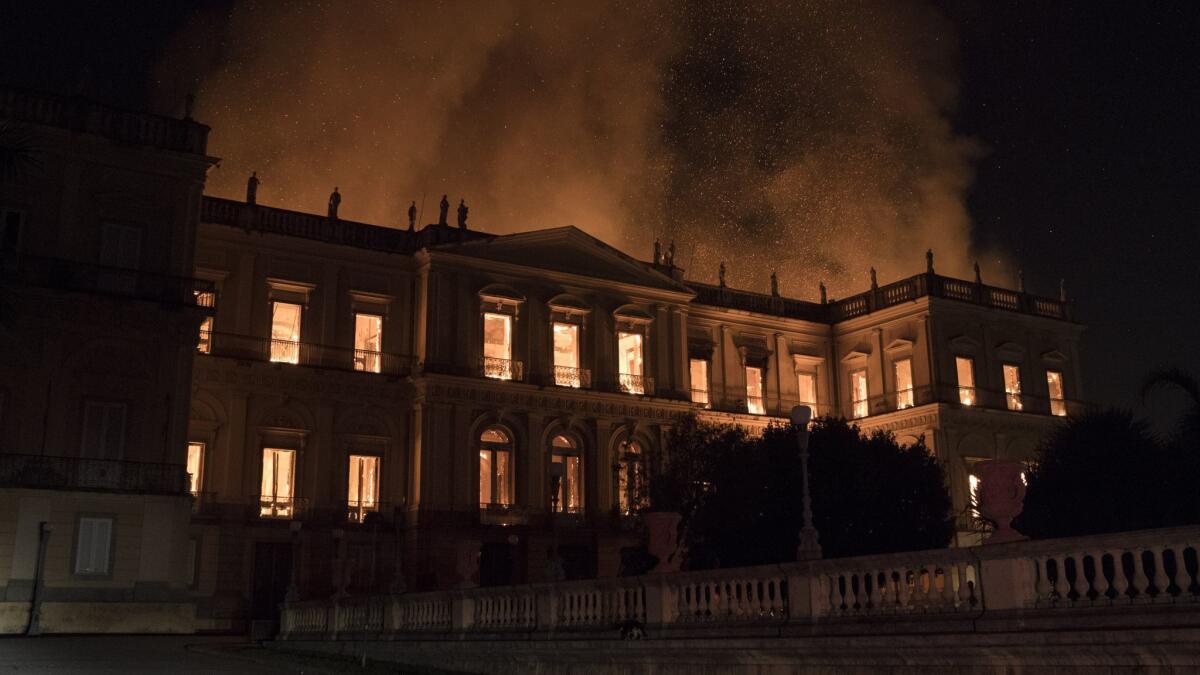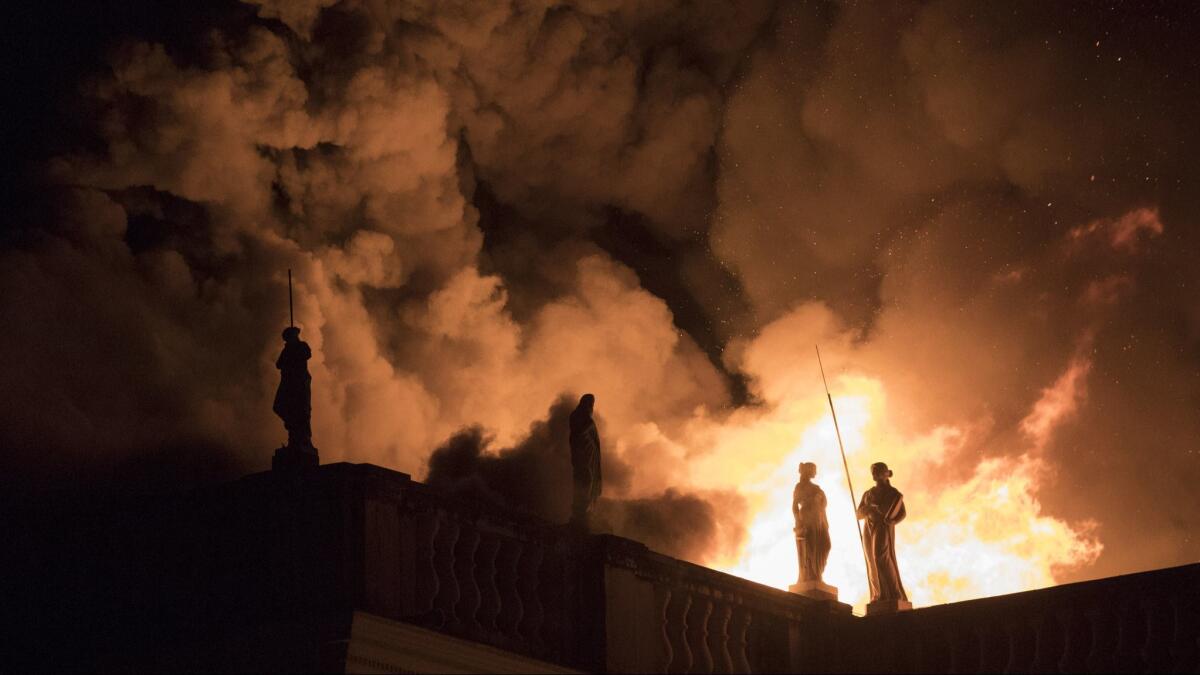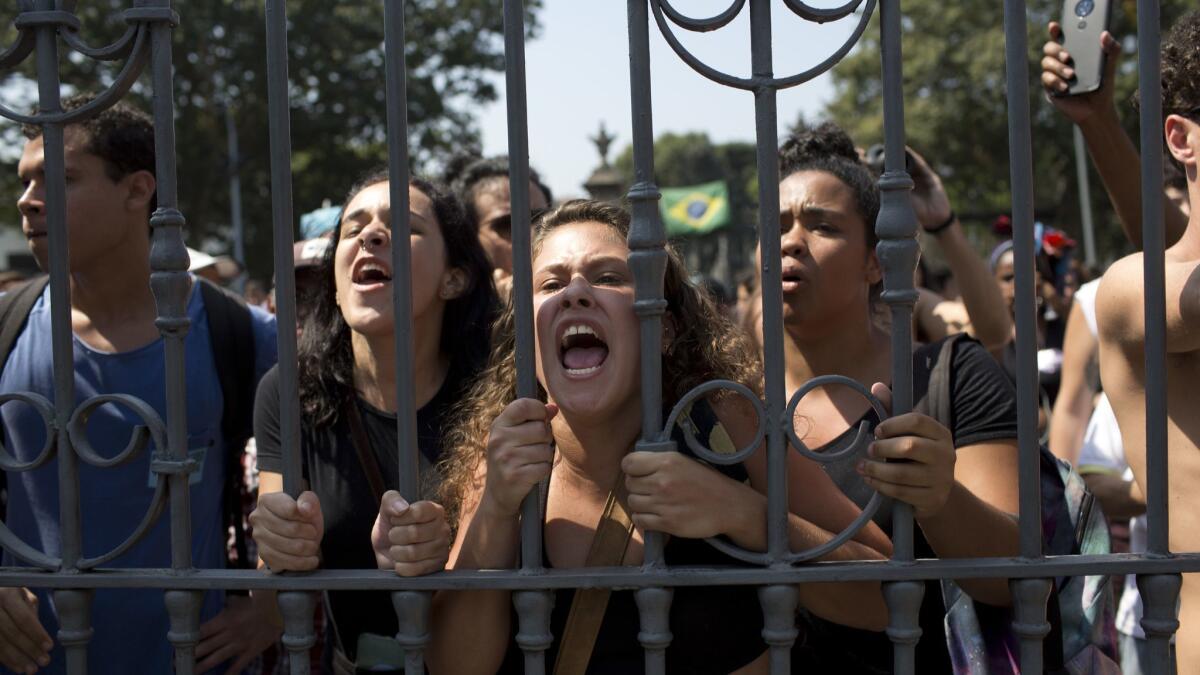With the flames barely out, the finger-pointing begins as massive fire engulfs famed Rio museum

- Share via
Reporting from Rio de Janeiro — Smoke rose Monday from the burned-out hulk of Brazil’s National Museum, as recriminations flew over who was responsible for a huge fire that destroyed at least part of Latin America’s largest archive of historical artifacts and documents.
A few hundred protesters gathered outside the museum gates tried several times to push into the site. They demanded to see the damage and called on the government to rebuild. Police pushed the crowd back with pepper spray, tear gas and batons.
The museum’s director said part of the collection was destroyed, but that it was not yet possible to detail the losses. The collection of 20 million items included Egyptian and Greco-Roman artifacts and the oldest human skull found in the Western Hemisphere. The building was once the home of the Portuguese royal family.
President Michel Temer called it “a sad day for all Brazilians.”
“Two hundred years of work, investigation and knowledge have been lost,” Temer said in a statement.
It was not clear how the fire began Sunday evening, when the museum was closed. But the flames quickly fueled criticism over Brazil’s dilapidated infrastructure and budget deficits as the nation prepares for national elections in October.
“Just crying doesn’t solve anything,” Alexander Kellner, the museum’s director, told reporters at the scene. He became emotional as he described plans to salvage what was left of the collection and rebuild. “We have to act.”

Kellner said the institution had recently secured approval for money for a planned renovation, including an upgrade of the fire-prevention system.
“Look at the irony. The money is now there, but we ran out of time,” he said.
Fire department spokesman Roberto Robadey said firefighters got off to a slow start because the two fire hydrants closest to the museum did not work. Instead, trucks had to gather water from a nearby lake.
Kellner said there were fire extinguishers on the site, but it was not clear if there were sprinklers, which are problematic for museums because water can damage objects.
The building was still standing Monday morning, but much of it appeared to have been gutted. A few hundred people crowded at the gates, some in tears.
On the massive site where the museum sits, the fencing was dilapidated, stonework was cracked and lawns appeared untended.
“This fire is what Brazilian politicians are doing to the people,” said Rosana Hollanda, a 35-year-old high school teacher, who was crying Monday at the gates. “They’re burning our history, and they’re burning our dreams.”
Roberto Leher, the rector of the Federal University of Rio de Janeiro, of which the museum is a part, told reporters that the building needed an upgrade to its electrical and water systems and a new fire-prevention plan.
“We all knew the building was in a vulnerable state,” he told reporters. Officials had been working with firefighters to reduce those risks, he added.
“A fire of this scale, the reality unfortunately showed this, we needed a systematic intervention,” he said.

Asked by a reporter why such disasters don’t happen at cultural institutions in other countries, Kellner, the museum director, replied: “Ask yourself that. That’s a good question.”
Latin America’s largest nation has struggled to emerge from its worst recession in decades. The state of Rio de Janeiro has been particularly hard hit in recent years thanks to a combination of falling prices for oil, one of its major revenue sources, mismanagement and massive corruption.
On Instagram, Rio Mayor Marcelo Crivella called on the country to rebuild.
“It’s a national obligation to reconstruct it from the ashes, recompose every eternal detail of the paintings and photos. Even if they are not original, they continue to be a reminder of the royal family that gave us independence, the [Portuguese] empire and the first constitution and national unity,” he said.
UPDATES:
10:04 a.m.: This article was updated throughout with additional details and reaction.
This article was originally published at 6:35 a.m.
More to Read
Sign up for Essential California
The most important California stories and recommendations in your inbox every morning.
You may occasionally receive promotional content from the Los Angeles Times.












